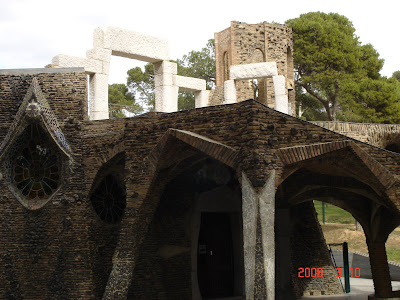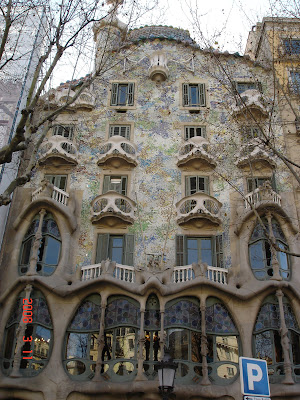In the interest of brevity I am structuring part2 differently. There are numerous sources to find more details on each of these historic sites. I will focus on the places we visited and my Impressions. If you like Barcelona, definitely read http://en.wikipedia.org/wiki/Barcelona
We covered the following culture sites today
Olympic Village: Home of the 1992 Olympic games. If you remember the Archer lighting the Olympic torch and the diving platforms where you could see entire Barcelona, it should bring back the memories of the games.
Palau Nacional: Which is the national art museum of Cataluña was a palace originally built for 1929 world’s fair. The building’s architecture looks impressive but Catalans don’t consider it so. It was actually a replica of many famous buildings of the time and hence lacks in originality.
 Santa Maria del Mar: A church built around the 13th and 14th century looks very Dark and gloomy from exterior but interiors stand in sharp contrast. It is a good example of gothic architecture.
Santa Maria del Mar: A church built around the 13th and 14th century looks very Dark and gloomy from exterior but interiors stand in sharp contrast. It is a good example of gothic architecture.  Palau de la Música Cataluña – is a concert hall built in modernistic style in early 20th century very similar to the works of Gaudi. It has been declared a UNESCO world heritage site. Some of us would come back later in the week to get tours and even see concerts.
Palau de la Música Cataluña – is a concert hall built in modernistic style in early 20th century very similar to the works of Gaudi. It has been declared a UNESCO world heritage site. Some of us would come back later in the week to get tours and even see concerts.  Picasso Museum: If you haven’t seen or don’t know much about Picasso this is a good place to visit to learn more about him. It is housed in adjoining medieval houses and has extensive collection of his art but not necessarily his most popular works.
Picasso Museum: If you haven’t seen or don’t know much about Picasso this is a good place to visit to learn more about him. It is housed in adjoining medieval houses and has extensive collection of his art but not necessarily his most popular works.Check out some of his art work
http://www.art.com/asp/display_artist-asp/_/crid--16/pg--5/Pablo_Picasso.htm
It was almost 9:30 Pm when we got back from the Picasso museum and most of crashed in our hotel beds. I spent some time keeping my Journal up to date. As part of the course we were required to maintain a journal and I took particular interest in not just noting and observing my interests but also attempting to draw and depict art and architecture
Thursday march 13th 2008: Figueres and Pubol
Today we headed to figures and Pubol for a day trip. Figueres was the home town of Dali, the famous artist who pioneered the technique of surrealism. I didn’t know much about Dali before my visit and was totally astonished by his creativity and imagination. Most of his paintings had so much depth, symbolisms and hidden meanings that one could analyze them for hours. He also experimented with other forms of art and in fact the Museum in figures was designed and decorated by him. He put in various forms of art and creations, 3-Dimensional art that were especially intriguing. Though this place is Hour and half from Barcelona it’s a must visit for any modern art fan.
Learn more about Dali
http://en.wikipedia.org/wiki/Salvador_Dal%C3%AD
Check out some of his paintings
http://www.dali-gallery.com/html/paintings.htm
Pubol is about half an hour away from Figueres and houses the castle that Gala, Dali’s wife, lived in. Dali and gala had a very interesting relationship and lived apart most of the time. Gala’s residence at Pubol is a great sight in its own right and is well decorated with Dali’s artwork. I also managed to sneak around the village which gave me a good glimpse of rural ‘Catalan’ scene in modern times. I found it an interesting mix of cultures.

We started out with dinner at a Tapas place which was excellent and then heading to a friend’s friend apartment for some drinks. Our first stop was a local Bar which seems like a college hangout and drew a pretty young crowd. Unlike in US the drinking age in Europe is 18 years and no one ever seems to check Ids. I forget the place’s name but it translates to “Black Sheep” We later headed out to club “Opium” I was back home by 5 am. Obviously everyone said that I left early.
We had the day off to visit any site we choose and I like most others decided to visit Casa Mila, also known as La Pedrara. Another Gaudi’s masterpiece, this is apartment complex that was actually completed and is still in habited. This truly shows the genius of Gaudi’s engineering skills as well as aesthetic qualities. The displays and exhibits inside, as well as the entire building provides a great insight into gaudi’s philosophy and vision. This is a must visit and preferably this should be the First Gaudi you see in Barcelona.

Later that evening I went down to see the musical fountains at the Palace. I haven’t seen many musical fountains before and found this one very interesting and entertaining. In talking with friends later they said it was too touristy and reminded them of Disneyland. I still think the Muscial fountains are quite a sight and you should put this in your calendar if you can.
After a short class on Saturday where we wrapped up our course and tried to relate design to strategy, we had the rest of weekend free. I caught up with my friend who showed me around some shopping , La Rambalas, some bars and good dinner places. I was getting more of the Barcelona city experience. On Sunday we went to place called “Parc de Laberint’ which was beautiful Duke’s castle with a garden and labyrinth. This is a very romantic place and I definitely recommend it for couples. We also stopped by Parc de la Cuitedala, caught a glimpse of the ‘Arc de triumph’ and did some boating. If anyone is interested the zoo is at this park.





 My first reaction after stopping right in front of Sagraga familia was that of awe. The structure was immense the engravings so complex. I was just amazed at the complexity while other raised questions on its aesthetic appeal. It does invoke different reactions from different people but commonality is that those reactions are extreme. Interesting aspect of Sagrada familia is its still in construction and it was designed way beyond what was possible in his time. It speaks to Gaudi’s visionary approach while the design is further validation of his engineering prowess. The church is controversial in many ways as the original designs were destroyed and other architects chose to deliberately deviate while constructing other facads (walls). The interior was also very well thought of with pillars shaped as trees and branches, ceiling depicting leaves and skylight give an impression of a waterfall. Inspiration Gaudi draws from nature is very evident. I could talk about Sagrada Familia endlessly but I will suggest that you pull out certain articles or wikipedia as they would more accurately represent all facts about its history.
My first reaction after stopping right in front of Sagraga familia was that of awe. The structure was immense the engravings so complex. I was just amazed at the complexity while other raised questions on its aesthetic appeal. It does invoke different reactions from different people but commonality is that those reactions are extreme. Interesting aspect of Sagrada familia is its still in construction and it was designed way beyond what was possible in his time. It speaks to Gaudi’s visionary approach while the design is further validation of his engineering prowess. The church is controversial in many ways as the original designs were destroyed and other architects chose to deliberately deviate while constructing other facads (walls). The interior was also very well thought of with pillars shaped as trees and branches, ceiling depicting leaves and skylight give an impression of a waterfall. Inspiration Gaudi draws from nature is very evident. I could talk about Sagrada Familia endlessly but I will suggest that you pull out certain articles or wikipedia as they would more accurately represent all facts about its history.







